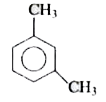Which of the following compounds can yield only one monochlorinated product upon free radical chlorination?
2,2-Dimethylopropane
2-Methylpropane
2-Methybutane
n-Butane
The correct Answer is:A
To determine which of the given compounds can yield only one monochlorinated product upon free radical chlorination, we need to analyze each compound based on the types of hydrogen atoms present. Monochlorination refers to the substitution of one hydrogen atom with a chlorine atom in the presence of chlorine radicals.
1. Understand Monochlorination:
- Monochlorination is the process where one hydrogen atom in an alkane is replaced by a chlorine atom. The outcome depends on the types of hydrogen atoms present (primary, secondary, or tertiary).
2. Analyze the First Compound: 2,2-Dimethylpropane (C5H12):
- Structure:
CH3|CH3−C−CH3|CH3
- All hydrogen atoms are equivalent because they are attached to the same carbon (tertiary carbon).
- Result: Only one type of hydrogen leads to one monochlorinated product (e.g., 2,2-dimethyl-2-chloropropane).
3. Analyze the Second Compound: 2-Methylpropane (C5H12):
- Structure:
CH3∣CH3−CH−CH2−CH3
- There are primary and secondary hydrogens. Chlorination can occur at different positions leading to multiple products.
- Result: More than one monochlorinated product.
4. Analyze the Third Compound: 2-Methylbutane (C6H14):
- Structure:
CH3∣CH3−CH−CH2−CH3
- Similar to the previous compound, there are different types of hydrogens (primary and secondary).
- Result: More than one monochlorinated product.
5. Analyze the Fourth Compound: n-Butane (C4H10):
- Structure:
CH3−CH2−CH2−CH3
- This compound has primary hydrogens at both ends and secondary hydrogens in the middle, leading to multiple products.
- Result: More than one monochlorinated product.
6. Conclusion:
- The only compound that yields only one monochlorinated product upon free radical chlorination is 2,2-dimethylpropane.
Final Answer:
The correct answer is 2,2-dimethylpropane.
- Monochlorination is the process where one hydrogen atom in an alkane is replaced by a chlorine atom. The outcome depends on the types of hydrogen atoms present (primary, secondary, or tertiary).
- Structure:
CH3|CH3−C−CH3|CH3
- All hydrogen atoms are equivalent because they are attached to the same carbon (tertiary carbon).
- Result: Only one type of hydrogen leads to one monochlorinated product (e.g., 2,2-dimethyl-2-chloropropane).
- Structure:
CH3∣CH3−CH−CH2−CH3
- There are primary and secondary hydrogens. Chlorination can occur at different positions leading to multiple products.
- Result: More than one monochlorinated product.
- Structure:
CH3∣CH3−CH−CH2−CH3
- Similar to the previous compound, there are different types of hydrogens (primary and secondary).
- Result: More than one monochlorinated product.
- Structure:
CH3−CH2−CH2−CH3
- This compound has primary hydrogens at both ends and secondary hydrogens in the middle, leading to multiple products.
- Result: More than one monochlorinated product.
- The only compound that yields only one monochlorinated product upon free radical chlorination is 2,2-dimethylpropane.
The correct answer is 2,2-dimethylpropane.
Topper's Solved these Questions
- BOOK - NCERT FINGERTPS ENGLISHCHAPTER - HALOALKANES AND HALOARENESEXERCISE - Physical properties7videos
HALOALKANES AND HALOARENES
- BOOK - NCERT FINGERTPS ENGLISHCHAPTER - HALOALKANES AND HALOARENESEXERCISE - Chemical reactions68videos
HALOALKANES AND HALOARENES
- BOOK - NCERT FINGERTPS ENGLISHCHAPTER - HALOALKANES AND HALOARENESEXERCISE - Nomenclature6videos
HALOALKANES AND HALOARENES
- BOOK - NCERT FINGERTPS ENGLISHCHAPTER - GENERAL PRINCIPLES AND PROCESSES OF ISOLATION OF ELEMENTSEXERCISE - Assertion And Reason15videos
GENERAL PRINCIPLES AND PROCESSES OF ISOLATION OF ELEMENTS
- BOOK - NCERT FINGERTPS ENGLISHCHAPTER - POLYMERS EXERCISE - NCERT Exemplar9videos
POLYMERS
Similar Questions
Knowledge Check
- Question 1 - Select One
Which of the following isomeric heptanes can yield seven differentt monochlorinated products upon free radical chlorination?
A2,2-DimethylpentaneB2-methylhexaneC3-MethylhexaneD2,4-dimethylpentane - Question 2 - Select One or More
Which of following compounds can exhibit free rotation?
A B
B C
C D
D
- Question 3 - Select One
Which one of the following compounds give only one isomer upon nitration ?
A B
B C
C D
D
Which of the following is the only exothermic oxide of chlorine?
View SolutionWhich of the following reactions will not yield alcohol as the major product ?
View SolutionWhich of the following compounds on hydrolysis yields a carboxylic acid?
View SolutionIn which of the following compound has only one type of hybridised carbon atom?
View SolutionWhich of the following compound will give four monochloro (structural) product on monochlorination.
View Solution

